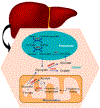New therapeutics for primary hyperoxaluria type 1
- PMID: 35266883
- PMCID: PMC9232952
- DOI: 10.1097/MNH.0000000000000790
New therapeutics for primary hyperoxaluria type 1
Abstract
Purpose of review: Primary hyperoxaluria type 1 (PH1) is a rare genetic disorder that causes hepatic overproduction of oxalate and, often, nephrocalcinosis, nephrolithiasis, chronic kidney disease, and kidney failure. The purpose of the review is to provide an update on current emerging therapies for the treatment of PH1.
Recent findings: Use of ribonucleic acid interference (RNAi) therapeutics that target the liver to block production of key enzymes along pathways that generate oxalate is a promising approach. Available evidence supports the efficacy of both Lumasiran (targeting glycolate oxidase) and Nedosiran (targeting hepatic lactate dehydrogenase (LDHa)) to reduce urinary oxalate excretion in PH1. The efficacy of alternative approaches including stiripentol (an anticonvulsant drug that also targets LDHa), lanthanum (a potential gastrointestinal oxalate binder), and Oxalobacter formigenes (a bacterium that can degrade oxalate within the gastrointestinal tract and may also increase its secretion from blood) are all also under study. Genetic editing tools including clustered regularly interspaced short palindromic repeats/Cas9 are also in preclinical study as a potential PH1 therapeutic.
Summary: Novel treatments can reduce the plasma oxalate concentration and urinary oxalate excretion in PH1 patients. Thus, it is possible these approaches will reduce the need for combined kidney and liver transplantation to significantly decrease the morbidity and mortality of affected patients.
Copyright © 2022 Wolters Kluwer Health, Inc. All rights reserved.
Conflict of interest statement
Conflict of interest
JCL has received consulting fees from Alnylam, OxThera, Dicerna, Federation-Bio, Synlogic, Orfan-Bridgebio, and Novobiome, and grant support from Alnylam, Allena, Retrophin, OxThera, and Dicerna.
Figures

Comment in
-
Urolithiasis/Endourology.J Urol. 2023 Feb;209(2):440-442. doi: 10.1097/JU.0000000000003056. Epub 2022 Nov 9. J Urol. 2023. PMID: 36349574 No abstract available.
References
-
- Cochat P, Deloraine A, Rotily M, Olive F, Liponski I, Deries N, et al. Epidemiology of primary hyperoxaluria type 1. Nephrology Dialysis Transplantation. 1995;10(supp8):3–7. - PubMed
-
- van Woerden CS, Groothoff JW, Wanders RJ, Davin JC, Wijburg FA. Primary hyperoxaluria type 1 in The Netherlands: prevalence and outcome. Nephrology Dialysis Transplantation. 2003;18(2):273–9. - PubMed
-
- Cochat P, Rumsby G. Primary hyperoxaluria. New England Journal of Medicine. 2013;369(7):649–58. - PubMed
-
- Belostotsky R, Frishberg Y. Novel therapeutic approaches for the primary hyperoxalurias. Pediatric Nephrology. 2020:1–14. - PubMed
-
- Beck BB, Hoyer-Kuhn H, Göbel H, Habbig S, Hoppe B. Hyperoxaluria and systemic oxalosis: an update on current therapy and future directions. Expert opinion on investigational drugs. 2013;22(1):117–29. - PubMed
Publication types
MeSH terms
Substances
Supplementary concepts
Grants and funding
LinkOut - more resources
Full Text Sources
Research Materials
Miscellaneous

